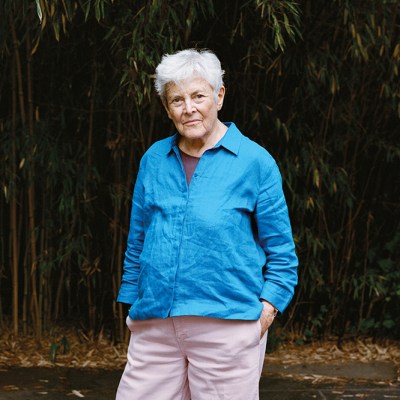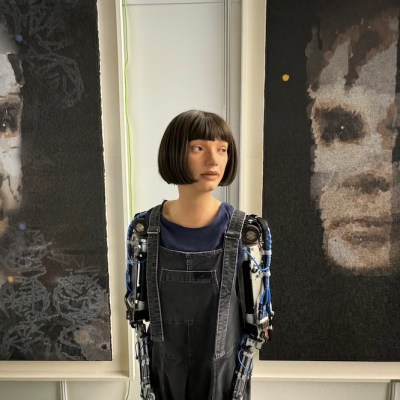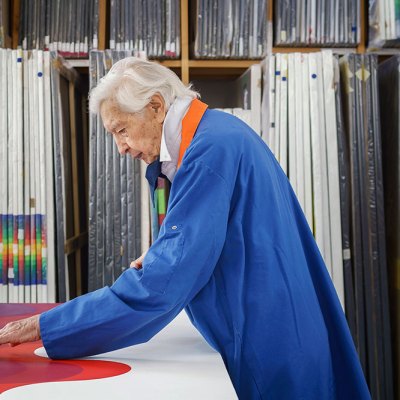From the January 2025 issue of Apollo. Preview and subscribe here.
On 21 December 1958, while on a bus travelling to an artist’s colony in southern France, Brion Gysin saw something strange. ‘We ran through a long avenue of trees and I closed my eyes against the setting sun,’ he wrote in his journal. ‘An overwhelming flood of intensely bright colours exploded behind my eyelids: a multidimensional kaleidoscope whirling out through space […] Was that a vision? What happened to me?’ He soon found an answer, in a book on neuroscience recommended by his friend William S. Burroughs. The flashes of light through the trees had resulted in a stroboscopically induced visual hallucination, otherwise known as ‘flicker’.
A firm believer in the mind-expanding potential of hallucinatory experiences, Gysin decided to create a device that would induce these visions on demand. With the help of a mathematics student at Cambridge, he developed a contraption consisting of a lightbulb, a cylinder with holes cut into the sides, and a turntable. In 1961 he took out a patent for the newly dubbed Dreamachine. The device was shown in several museums and galleries and got some press. But Alfred Barr Jr, the influential director of MoMA in New York, dismissed it out of hand: ‘The kinetic thing is over, what is now is Pop.’ Gysin concluded that his idea had been ‘too new’.
Inter-ena-cubo (1970), Paolo Scheggi. Tate, London. Photo: © Tate; © Associazione Paolo Scheggi

A similar fate befell many artists whose work appears in ‘Electric Dreams: Art and Technology Before the Internet’ at Tate Modern. The exhibition, which spans the early 1950s to the early ’90s, demonstrates the rich variety of artistic experiments with new tools that took place all around the globe during this period of rapid scientific and technological advances. There are more than 150 works, from motorised light sculptures to computer-generated graphics rendered with a mix of paint, plotters and pixels. But even if they generated a bit of buzz at first, very few of their creators became household names.
Now, it seems, their time has come. And not just at the Tate: two other museum exhibitions covering similar territory, ‘Radical Software: Women, Art & Computing 1960–1991’ at Mudam in Luxembourg and ‘Electric Op’ at the Buffalo AKG Art Museum, are also currently on view. The most obvious reason for this interest might be the recent rise in popularity of various forms of what can broadly be called digital art (although, now as then, some people will probably contest the label of ‘art’ in certain cases). The exhibition doesn’t make the connection explicitly, but it’s difficult not to think of it as a prehistory of sorts.
Take the room-sized interactive installations that punctuate the show. Carlos Cruz-Diez’s Chromointerferent Environment, first presented at the Museum of Contemporary Art in Caracas in 1974, features moving light projections that cast dizzying lines of colour on the white cube of the gallery as well as a scattered series of plinths and balloons (yes, these can and do pop, loudly). Monika Fleischmann and Wolfgang Strauss’s Liquid Views – Narcissus’ Digital Reflections, made in 1992 with the help of computer scientist Christian A. Bohn, centres on a touch-sensitive monitor with a camera that captures the viewer’s image and distorts it like a reflection on a watery surface. A direct lineage can be traced from works such as these to the high-tech ‘immersive’ installations – among them, in 2022, an updated version of Gysin’s Dreamachine – that have proliferated in the past few years.
Liquid Views (1992) by Monika Fleischmann and Wolfgang Strauss at ‘Arte Virtual’, Opera Metro, Madrid (1994; detail). ZKM Karlsruhe. © Monika Fleischmann and Wolfgang Strauss

Elsewhere, early experiments with computers and algorithms can be seen as precursors to the contemporary obsession with art made using artificial intelligence (and NFTs before that). Perhaps the most notable in this regard is the work of Harold Cohen, a moderately successful abstract painter who started learning to code in the late 1960s. He developed a series of computer programmes, named AARON, that could generate images and then ‘draw’ them with a robotic device on paper. Alongside an original drawing and archival material documenting the project, the exhibition includes a massive canvas with painted enlargements of AARON’s drawings.
Evidently, the artists in ‘Electric Dreams’ were advanced – not just in their technical abilities but also in their conceptual understanding of the evolving and increasingly entangled relationship between humans and machines. It’s a little ironic, then, that so much of the work now looks less futuristic than retro. To give just one example: AARON’s wobbly outlines and patches of flat colour remind me not so much of something Open AI’s DALL-E might spit out, but rather my own juvenile attempts at using MS Paint. That’s how technology works these days, constantly making its forerunners obsolete.
AARON #1 Drawing (1979), Harold Cohen. Tate, London. Photo: courtesy Harold Cohen Trust; © the artist

Perhaps, then, nostalgia is also a contributing factor in the current fascination for the pre-internet period – before big tech got quite so big. One of the most purely enchanting moments of the exhibition comes in Otto Piene’s Light Room (Jena), an installation composed of his 1960s ‘light machines’: perforated metal sculptures containing revolving lamps, pre-programmed to create the effect of what Piene described as light dancing across a darkened room. Watching them, I was transported back to my childhood bedroom, where I could never get to sleep unless my magic lantern was switched on.
And yet, as the exhibition reminds us, even in the earliest days our dreams of technology had a dark side too. Advancements in technology have always been driven by military and corporate interests, that’s nothing new. Piene’s light sculptures were born directly from his traumatic experience of being drafted at the age of 16 to serve as an anti-aircraft gunner in the Second World War. While on the lookout, he witnessed first-hand the most nightmarishly destructive capabilities of machines. Up to now, he later wrote, ‘We have left it to war to light up the sky with coloured signs and artificial and induced bursts of flame.’ Freedom, he suggested, would mean coming up with something equally spectacular – but just ‘for the fun of it’.
‘Electric Dreams: Art and Technology Before the Internet’ is at Tate Modern until 1 June.
From the January 2025 issue of Apollo. Preview and subscribe here.



